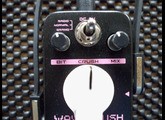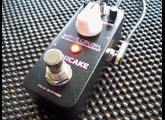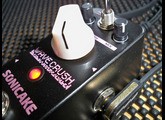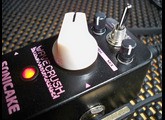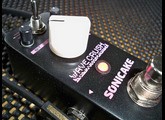« Big Range of Sounds with Added Features »
Published on 07/23/22 at 04:03
Best value:
Excellent
Audience:
Anyone
Bit crushers are a specialty pedal, and some may consider their use limited and when wanting a lo-fi sound. However, I do find them most appropriate for guitar when applied in a low dose, which I’ll address later. The Sonicake Wave Crush is a different animal, and for the price, it offers a lot of diversity.
First, the Bit Resolution ranges from 5-16 bits (when turned all the way counterclockwise, you have full 16 bits and clarity of signal). The Crush knob ranges from 44.1 kHz to 750 Hz (when turned all the way counterclockwise, you have the highest sample rate). The Dry/Mix knob controls how much of the original signal vs. wet you hear (when turned all the way counterclockwise, it’s all dry).
Depending on how broken up you want the signal, you can go from fully clean to a sputtering distortion, and with some fine tuning, a growly fuzz effect can be achieved. The way I like it with guitar is to have the Mix half-way and with both Bit Resolution and Crush turned up just a bit (e.g., 8-9 o’clock), which adds grain and growl for a more robust and thicker sounding crunch and lead – although I do turn the Mix up full with single-note lead playing.
I think where the Wave Crush shines the most is with synth, as it adds a lot of texture to very smooth tones, providing a massive range of possibilities from just one preset. But having said that, there is another very useful function on this true-bypass pedal. It has a Normal setting (neutral down-sampled sound), but a flip of the toggle produces a vintage Gramophone sound, and another flip produces a vintage radio sound. Both examples are demonstrated in the video. Both these are very cool if you’re looking for that effect, and it works equally well with various instruments and voice. To get the best results with either, all you have to do is place Mix on full with Bit Resolution and Crush totally off or up just a touch.
Now, although the Gramophone and Radio settings may seem limited, they also act as an EQ when applied to instruments. The Gramophone produces more mid-range, whereas the Radio produces more high-end – and just enough (to my ears) to make very usable and obvious differences in tone, when applied to guitar or keys.
Overall, the voice settings (Normal, Gramophone and Radio) are a big plus and when coupled with the other controls, thus making the Wave Crush a better bit crusher than others I have tried. And considering the price of only $59 USD, it’s a no-brainer if you’re looking for such a pedal. The micro size also is a benefit if your pedal board is getting a bit tight and you have limited room for this specialty effect.
First, the Bit Resolution ranges from 5-16 bits (when turned all the way counterclockwise, you have full 16 bits and clarity of signal). The Crush knob ranges from 44.1 kHz to 750 Hz (when turned all the way counterclockwise, you have the highest sample rate). The Dry/Mix knob controls how much of the original signal vs. wet you hear (when turned all the way counterclockwise, it’s all dry).
Depending on how broken up you want the signal, you can go from fully clean to a sputtering distortion, and with some fine tuning, a growly fuzz effect can be achieved. The way I like it with guitar is to have the Mix half-way and with both Bit Resolution and Crush turned up just a bit (e.g., 8-9 o’clock), which adds grain and growl for a more robust and thicker sounding crunch and lead – although I do turn the Mix up full with single-note lead playing.
I think where the Wave Crush shines the most is with synth, as it adds a lot of texture to very smooth tones, providing a massive range of possibilities from just one preset. But having said that, there is another very useful function on this true-bypass pedal. It has a Normal setting (neutral down-sampled sound), but a flip of the toggle produces a vintage Gramophone sound, and another flip produces a vintage radio sound. Both examples are demonstrated in the video. Both these are very cool if you’re looking for that effect, and it works equally well with various instruments and voice. To get the best results with either, all you have to do is place Mix on full with Bit Resolution and Crush totally off or up just a touch.
Now, although the Gramophone and Radio settings may seem limited, they also act as an EQ when applied to instruments. The Gramophone produces more mid-range, whereas the Radio produces more high-end – and just enough (to my ears) to make very usable and obvious differences in tone, when applied to guitar or keys.
Overall, the voice settings (Normal, Gramophone and Radio) are a big plus and when coupled with the other controls, thus making the Wave Crush a better bit crusher than others I have tried. And considering the price of only $59 USD, it’s a no-brainer if you’re looking for such a pedal. The micro size also is a benefit if your pedal board is getting a bit tight and you have limited room for this specialty effect.

